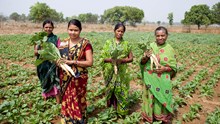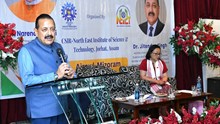
ISRO's satellite technology has become essential in revolutionizing Indian agriculture, offering a wide range of solutions that are enhancing productivity, efficiency, and sustainability. The integration of Earth observation data and meteorological information provided by ISRO’s remote sensing satellites is driving innovation across various agricultural domains. These advancements are not only helping farmers optimize their resources but also supporting governmental initiatives aimed at strengthening the agricultural sector.
One of the key aspects of ISRO’s contribution is its collaboration with the Ministry of Agriculture and Farmers Welfare through various flagship programs such as FASAL, NADAMS, CHAMAN, and KISAN. These programs leverage satellite data for crucial tasks like crop forecasting, drought assessment, and insurance, providing a data-driven approach to agricultural planning. For instance, FASAL (Forecasting Agricultural Output using Space, Agro-meteorology and Land-based observations) helps predict crop yields, while NADAMS focuses on the real-time monitoring of drought conditions, enabling timely interventions.
Moreover, ISRO’s involvement in the National Programme on the Use of Space Technology for Agriculture (NPSTA) further integrates space-based technology into farming operations. This initiative consolidates multiple projects under one umbrella, making it more efficient to use space technology in agricultural applications. The efforts are aimed at enhancing productivity through better crop management, pest detection, and resource optimization. By providing insights into weather patterns, soil moisture levels, and pest outbreaks, ISRO’s satellites empower farmers to make informed decisions that reduce input costs and maximize yield.
Economic Impact of Satellite Technology
The economic impact of these technologies is significant. The combination of satellite-based data and real-time agricultural intelligence is expected to lead to considerable savings in resources such as water and fertilizers, while simultaneously boosting crop production. As the adoption of satellite technology in agriculture continues to expand, particularly by 2030, the sector is set to experience profound transformation, ushering in an era of data-centric farming practices.
ISRO’s Key Satellites Supporting Agriculture
A few of the satellites currently in operation, such as Resourcesat-2, Cartosat-1, and RISAT-1, provide a wide range of data that supports these initiatives. Resourcesat-2, launched in 2011, helps in crop production forecasting, wasteland inventory, and disaster management support, offering multispectral images. Cartosat-1, which provides high-resolution images for cartographic mapping and topographic data, plays a key role in monitoring changes in land use and managing irrigation infrastructure. RISAT-1, designed to provide all-weather imaging, is particularly useful in monitoring paddy and jute during the monsoon season.
ISRO’s satellites also support a host of applications related to weather forecasting and disaster management. The Kalpana-1 satellite provides valuable meteorological data that aids in weather forecasting, while INSAT-3D and INSAT-3DR deliver critical atmospheric information, enabling timely warnings for disasters such as cyclones, floods, and droughts. These satellites are indispensable tools in managing the agricultural risks associated with climate change and ensuring that farmers have access to real-time weather data.
The development of products like the Operational Soil Moisture Product, based on data from the EOS-04 (RISAT-1A) satellite, exemplifies how ISRO’s technology is directly benefiting agriculture. This product provides high-resolution data on soil moisture, which plays a crucial role in irrigation planning and drought detection. The data is freely available on the Bhoonidhi portal, empowering farmers to make better decisions regarding water management. With an impressive retrieval accuracy of 92%, it is a powerful tool for ensuring sustainable farming practices.
Krishi-DSS: Empowering Farmers with Real-Time Data
A recent addition to ISRO’s satellite-based agricultural services is the Krishi-Decision Support System (Krishi-DSS). This system offers real-time data on crop conditions, weather patterns, water resources, and soil health, enhancing crop management and productivity. Krishi-DSS, developed using technology similar to the Gati Shakti initiative, is a geospatial platform that can provide early warnings on pest outbreaks and extreme weather events, supporting farmers in making proactive decisions. It also aids in crop mapping and promotes practices like crop rotation and diversification, which are essential for maintaining soil health and ensuring food security.
The data derived from ISRO’s satellites is invaluable for a range of agricultural purposes, including crop assessment, damage assessment due to natural disasters, agro-met services, and disaster management. These satellite-based solutions offer an innovative, cost-effective way to tackle the challenges of modern agriculture in India.
As satellite technology continues to evolve, its role in shaping the future of Indian agriculture is poised to become even more prominent, offering a sustainable path toward achieving food security and economic stability for the country’s farmers.
















